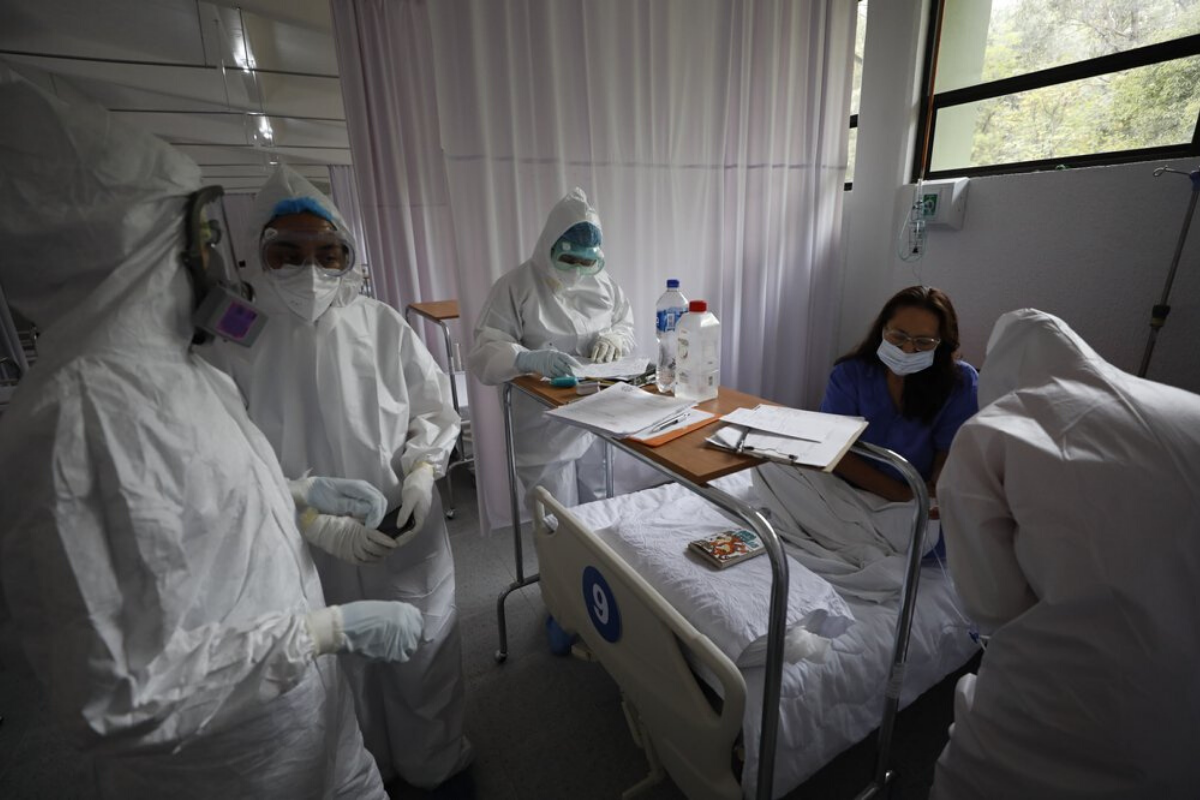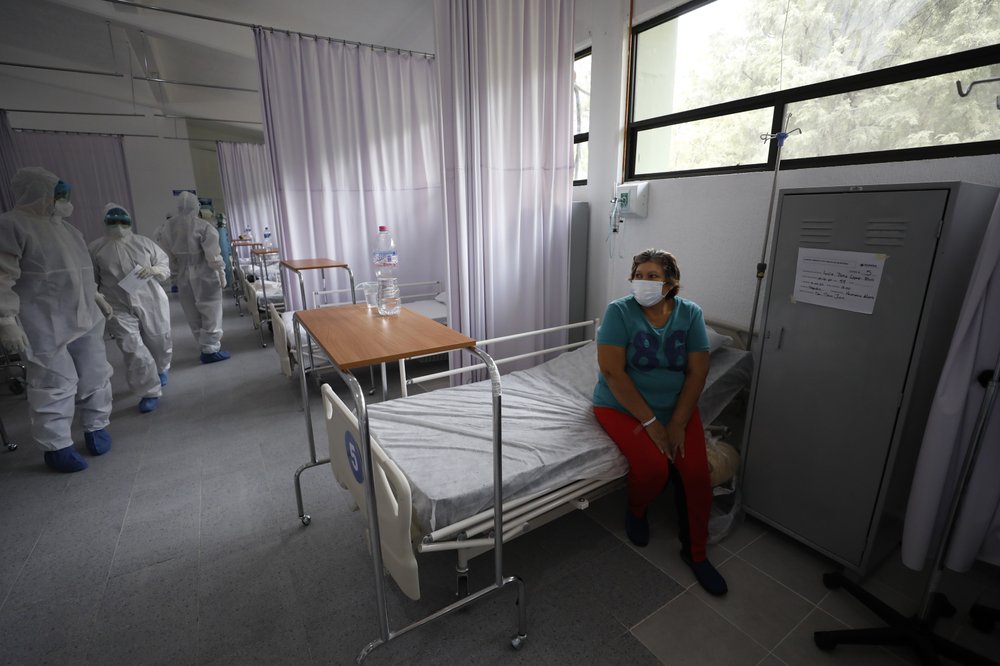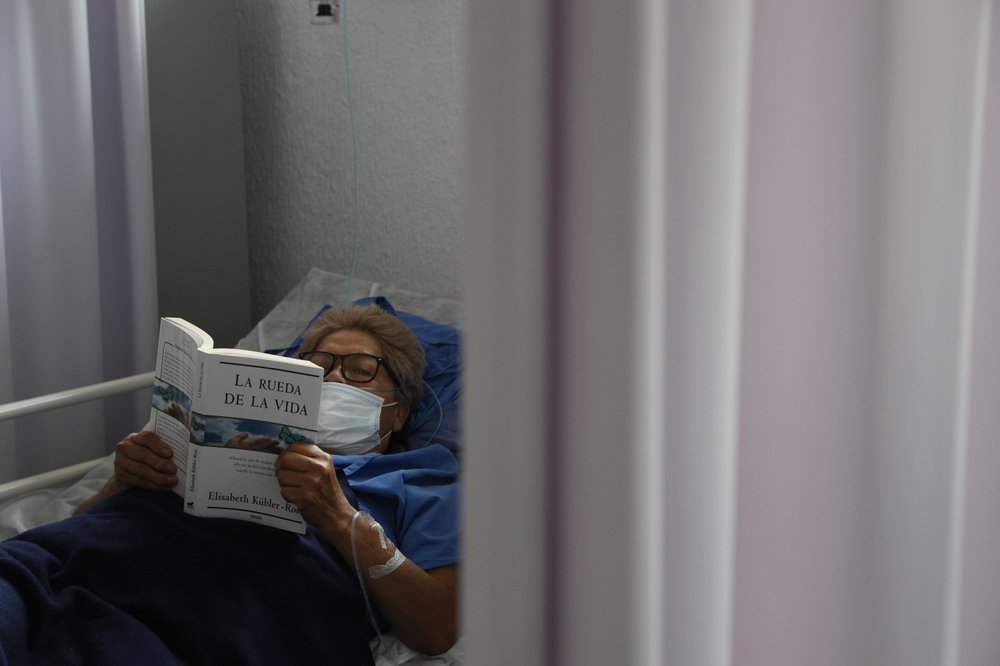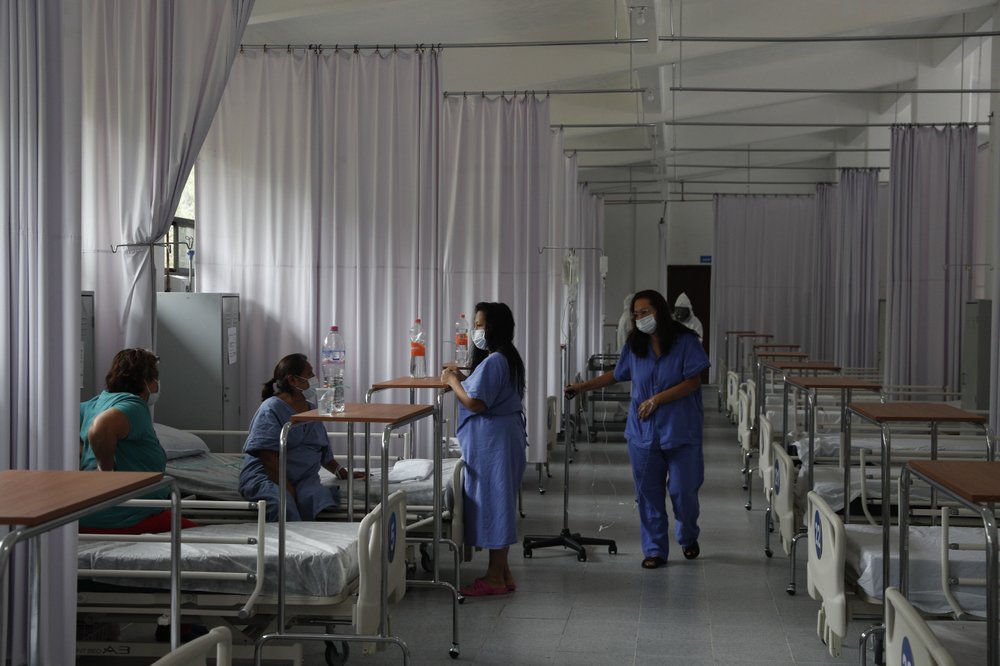

Medical staff wearing protective gear check on patient Magdalena Torres, in the women’s ward of a COVID-19 hospital at Military Camp 1, Naucalpan, Mexico State, part of the Mexico City metropolitan area, Tuesday, June 23, 2020. (AP Photo/Rebecca Blackwell)
By MARÍA VERZA and CHRISTOPHER SHERMAN
MEXICO CITY (AP) — In a Mexican army barracks, hospital beds have replaced bunks. Oxygen tanks fill the room that held assault rifles. The building that previously housed soldiers between missions to eradicate opium poppy crops is now outfitted for up to 100 patients infected with the coronavirus.
The two-story barracks is one of more than 100 spaces converted by the military to treat COVID-19. But since it opened in May, only about half of its beds have been occupied.
That’s because Mexico’s health system has so far not been overwhelmed by the pandemic. The government early on chose to invest in expanding hospital beds rather than testing for the virus. Despite recording nearly three times more deaths than health officials initially predicted, beds are widely available.
Last week, a dozen patients lay in a ward at the barracks hospital. Most beds were labeled with the patient’s name and “PB Covid” for possible COVID-19.
The government now has nearly 900 designated COVID-19 hospitals around the country, up from 645 in April, said Health Undersecretary Hugo López-Gatell, the government’s point man on the pandemic.


Recovered coronavirus patient Lucia Pina waits with her belongings to be discharged from a COVID-19 hospital at Military Camp 1 in Naucalpan, in Mexico City metropolitan area, Tuesday, June 23, 2020. (AP Photo/Rebecca Blackwell)
“The net result is the objective that we have sought since the start,” López-Gatell said, explaining that Mexico had successfully avoided any emergency “where there are people who can’t be attended to because there isn’t a bed available.” He said that means not just beds, but personnel and other equipment too.
Mexico ranks seventh globally in pandemic deaths, with more than 26,000 reported fatalities from COVID-19, a figure considered a significant undercount because of the low testing rate.
The sprawling capital of Mexico City —home to 10 million people surrounded by 10 million more in the metro area— is the country’s virus epicenter. It has nearly a quarter of confirmed infections. The city has many times more intensive care beds now than at the start of the year. Some 6,000 people have died here.
Adding bed capacity was wise, but hospital occupancy is as high as it is because the government has not managed the pandemic well, said Gordon McCord, an associate dean and economics professor at the School of Global Policy and Strategy at the University of California, San Diego.
Abundant testing, contact tracing and physical distancing “must go hand-in-hand with preparing hospitals,” said McCord, who focuses on public health and development economics. “No amount of the latter will be enough without the former.”


Teresa Juarez reads “The Wheel of Life” by Elisabeth Kubler-Ross, as she rests while being treated with supplemental oxygen in the women’s ward of a COVID-19 hospital in Military Camp 1 in Naucalpan, Mexico State, part of the Mexico City metropolitan area. (AP Photo/Rebecca Blackwell)
As with any disease, some deaths are inevitable regardless of the number and type of hospital beds available. Experts say another contributing factor is the reluctance of many people to go to the hospital, something Mexico City’s mayor sought to counter by announcing expanded testing and a door-to-door informational campaign in June.
While Mexico’s population is younger than those in hard-hit Western European countries like Italy and Spain, it’s also unhealthy. Mexico has the highest diabetes rate among countries in the Organization for Economic Cooperation and Development, and one of the highest obesity rates, with 72.5% of adults overweight or obese. Doctors say being obese significantly raises the risk that a person will develop a severe case of COVID-19.
Much of the expansion of beds for COVID-19 patients has been at lower-level facilities that are not designed to handle serious cases like a top-tier hospital, said Dr. Francisco Moreno, an infectious disease specialist and head of the COVID-19 response at ABC Medical Center in Mexico City.
While there are no reliable statistics on whether coronavirus patients are more or less likely to survive in Mexico than another country, Moreno described the death rate in lower-level hospitals as worrisome.
“The mortality in those hospitals is very high, but the system hasn’t been ‘saturated’ because you have beds available,” he said. “If you open beds in other hospitals, you not only don’t have intensive care services, but you also don’t have the doctors who are trained to attend to these patients.”
At the converted barracks on Military Base No. 1 in Mexico City, Lt. Col. Raúl Sandoval, a pulmonologist, said doctors have what they need to care for COVID-19 patients who require oxygen, but they transfer patients who require intensive care. They have not had any patients die.
Juan Manuel Garcia Ortegon, coordinator of Mexico City’s command center, oversees the people making sure patients are routed to hospitals with open beds.


Coronavirus patients in various stages of recovery talk inside the women’s ward at a COVID-19 hospital inside Military Camp 1, in Naucalpan, Mexico State, part of the Mexico City metropolitan area, Tuesday, June 23, 2020. (AP Photo/Rebecca Blackwell)
“The idea is that people aren’t bouncing from hospital to hospital,” García said. He noted that Mexico City started the year with 135 intensive care beds. It now has 986 for intubated patients.
“Here the name of the game is avoiding saturation,” García said. “We can’t allow to happen here what happened to countries that the pandemic caught less prepared.”
Brazil, Chile, Peru and Ecuador, among other Latin American countries, have been fighting nearly unchecked rates of infection for months. Cities across the region have seen intensive-care occupancy rates rise above 80 and 90 percent, well into the zones considered dangerous and overwhelming.
Dr. José Narro, a former Mexican health secretary and ex-rector of Mexico’s National Autonomous University, credited the government for expanding hospital capacity but said that move obscured how devastating the virus has been in Mexico.
He cited anecdotal evidence that, when people who have delayed treatment arrive at a medical center, they are often in such critical condition that they only occupy a bed for a few days before dying. That helps explain why services have not been overwhelmed, Narro said.
Moreno has seen it repeatedly in his hospital. People prefer to stay at home and tolerate symptoms for a week, but they are unaware that their oxygen level is decreasing day by day.
“And then when they come, you can’t save them with oxygen through a mask, and you have to intubate,” he said.
Despite the questions, President Andrés Manuel López Obrador praises the military for helping to expand hospital bed space.
No one with coronavirus has lacked for medical attention or “been left without a bed,” López Obrador said during an appearance in June.


